Optimum Weight Design of Functionally Graded Material Gears
2015-11-01JINGShikaiZHANGHeZHOUJingtaoandSONGGuohua
JING Shikai*, ZHANG He ZHOU Jingtao, and SONG Guohua
1 School of Mechanical Engineering, Beijing Institute of Technology, Beijing 100081, China2 Key Lab of Contemporary Design and Integrated Manufacturing Technology, Ministry of Education,Northwestern Polytechnical University, Xi'an 710072, China
Optimum Weight Design of Functionally Graded Material Gears
JING Shikai1,*, ZHANG He1, ZHOU Jingtao2, and SONG Guohua1
1 School of Mechanical Engineering, Beijing Institute of Technology, Beijing 100081, China
2 Key Lab of Contemporary Design and Integrated Manufacturing Technology, Ministry of Education,Northwestern Polytechnical University, Xi'an 710072, China
Traditional gear weight optimization methods consider gear tooth number, module, face width or other dimension parameters of gear as design variables. However, due to the complicated form and geometric features peculiar to the gear, there will be large amounts of design parameters in gear design, and the influences of gear parameters changing on gear trains, transmission system and the whole equipment have to be taken into account, which increases the complexity of optimization problem. This paper puts forward to apply functionally graded materials (FGMs) to gears and then conduct the optimization. According to the force situation of gears, the material distribution form of FGM gears is determined. Then based on the performance parameters analysis of FGMs and the practical working demands for gears, a multi-objective optimization model is formed. Finally by using the goal driven optimization (GDO)method, the optimal material distribution is achieved, which makes gear weight and the maximum deformation be minimum and the maximum bending stress do not exceed the allowable stress. As an example, the applying of FGM to automotive transmission gear is conducted to illustrate the optimization design process and the result shows that under the condition of keeping the normal working performance of gear, the method achieves in greatly reducing the gear weight. This research proposes a FGM gears design method that is able to largely reduce the weight of gears by optimizing the microscopic material parameters instead of changing the macroscopic dimension parameters of gears, which reduces the complexity of gear weight optimization problem.
gears, optimum weight design, functionally graded materials, material distribution, additive manufacturing
1 Introduction*
Gears are widely used parts in mechanical transmission which feature the wide power range, high transmission efficiency, accurate transmission ratio and long service life[1]. The modern gear transmission is developing towards high speed, heavy load and lightweight. Reduction of gear weight can not only reduce the weight of the whole equipment, but also reduce the natural frequency of the gears, thereby weakening the mesh noise[2]. Especially for large transmission system, the weight decrease of gears has very practical value for reducing the useless power consumption as well as starting and braking energy consumption of transmission. Therefore on the premise of guaranteeing the reliability, conducting the optimal weight design of gears is of important significance.
There have been a number of studies conducting researches on gear weight optimization. Aimed at helical gears, ZAREFAR, et al[3], considered the module of gear,helix angle, number of teeth and face width as the design variables, and the contact stress and bending stress as constraints. Then they used random search algorithm for this optimization problem. WANG, et al[4], took center distance, gear weight, tooth deflection and gear life as objective functions, and the improved iterative weighted Tchebycheff (MIWT) method was proposed for the solution. For optimal gear weight design, YOKOTA, et al[5],constrained bending strength of gears, torsional strength of shafts and gear dimension, and then proposed non-linear integer programming (NIP) model which was solved by a modified genetic algorithm (GA). For minimum weight design problem of gear trains, SAVSANI, et al[6], proposed to use particle swarm optimization (PSO) and simulated annealing (SA) for the solution, and the superiority of the proposed methods on weight optimum design of gears was proved.
All of these gear weight optimization methods mentioned above consider gear tooth number, module, face width or other dimension parameters of gears as design variables. But due to the complicated forms and geometric features peculiar to the gears, there will be large amounts of design parameters in gear design, and the influence of gear parameters change on gear trains, transmission system and the whole equipment has to be taken into account, which increases the complexity of optimization problem.
Functionally graded materials (FGMs) are new materials developed on the basis of a new concept of materials design. From the surface to the inside, the material composition,microstructure, and organization are not homogeneous, but gradually change in a certain direction that forms gradient distribution, resulting in a single or composite gradient function of the heterogeneous materials[7]. Because of the continuous change of its internal composition and structure,the function of this kind of material changes continuously as well, which just meets the requirement for parts working in different environments[8]. In addition, in practical applications, it is often desirable that the part designed has not only a high strength and stiffness, but also a small weight, volume or price. FGMs, which are composed of materials with different densities and prices, provide a new way to reduce the overall weight and price of the part. Traditional manufacturing methods for FGMs have problems including thin gradient layers, high production cost and long production cycle. Additive manufacturing(AM) technology is characterized by layer-by-layer deposition and simultaneous geometry shaping and material distributing in manufacturing process, which provides an excellent method for FGMs manufacturing[9-10]. In the design process of a part, the part shape and material is restricted to traditional manufacturing process. While in the design for additive manufacturing (DFAM), we don't have to consider the traditional manufacturing process, providing the design of part shapes and material distributions a large freedom. Thus AM technology provides a better approach for product design. As a result, AM technology has distinctly unique advantages in both FGMs design and manufacturing.
Many researches were also conducted on optimum design of FGM parts. OBATA, et al[11], considered maximizing the minimum strength-to-weight ratio of FGMs as objective, to optimize the graded distribution of material. Assuming that microstructure parameters varied along the layer thickness direction, and the microstructure was determined by the volume fraction of material, aspect ratio and coordinates of fiber, NADEAU, et al[12], conducted microstructure optimization of FGMs. Considering the heat transfer problems of cylinder and taking minimizing the maximum thermal stress as objective, TANIGAWA, et al[13],optimized the graded material distribution as well. TANAKA, et al[14], used direct sensitivity method for the optimal material distribution that minimized the maximum stress in the cylinder. By taking thickness, material volume fraction and rotating speed as design variables, and energy storage density of the rotor as objective function, YAN, et al[15], used sequential quadratic programming (SQP)method and accomplished optimization design for shape and material distribution of FGM flywheel rotor. TORABIZADEH[16]analyzed the effect of geometric nonlinearity on displacements and stresses in beams made of FGM. LV, et al[17], created a common cylindrical involute gear model and a FGM cylindrical involute gear model, and then the finite element analysis of their bending stress was made. The analysis result showed that applying FGMs to gears was feasible, nevertheless, the optimization problem of the optimum material distribution design was not put forward. Seen from the above studies, through optimization of the microscopic material distribution of FGMs, we can get the corresponding macro performance of FGM parts,such as the energy storage density, weight, and mechanical properties, etc.
Herein, this paper puts forward applying FGMs to gears and thus forming a new optimization model that reduces weight of gears by optimizing the material distribution; that is, taking the microscopic parameters, i.e., coefficients of material distribution function, as design variables without changing the macroscopic parameters, such as gear size,modulus and the number of teeth. Thus a simple optimization problem can be formed and under the optimal condition the weight of gears can be largely reduced. The proposed method also provides a new train of thought for the lightweight design of gears and other parts.
2 Material Distribution Design of FGM Gears
The basic design thought of FGMs is expressed as follows[18]: according to the specific working conditions and requirements, choose two or more kinds of materials with different properties. Then by continuously changing composition and structure of these materials, blur the internal interface and get the heterogeneous material with gradually changing function, which eliminates or reduces the non-match elements of performance at the combining site. Therefore the analysis of specific work situation of gears should be carried on first before determining the material distribution form of FGMs.
For two meshing gears, gear teeth are the main stressed part, hence this paper carry on FGMs design and optimization only for gear tooth. For tooth bending fatigue strength calculation, gear tooth is often taken as a cantilever beam with rectangular cross-section. And then using method of material mechanics, the designing and checking of tooth surface contact strength and tooth root bending strength are conducted. Similarly, when considering the material distribution form of FGMs on gear tooth, we take gear tooth as cantilever beam of rectangular section. The hollow section steels and I-steels can reasonably and efficiently take use of the strength of materials. With reference to this characteristic, the intuitive idea is that FGM tooth can also get the functions similar to the hollow steels or I-steels by reasonably distributing materials on tooth. Therefore, the tooth profile surface is taken as the reference feature, and the material distributions can be illustrated by material volume fraction φ, which is a function of distance d from the calculated position to the reference feature, that is (),dφφ= as shown in Fig. 1. Fig. 2 illustrates a 3D model of FGM tooth modeled using the above discussed approach.
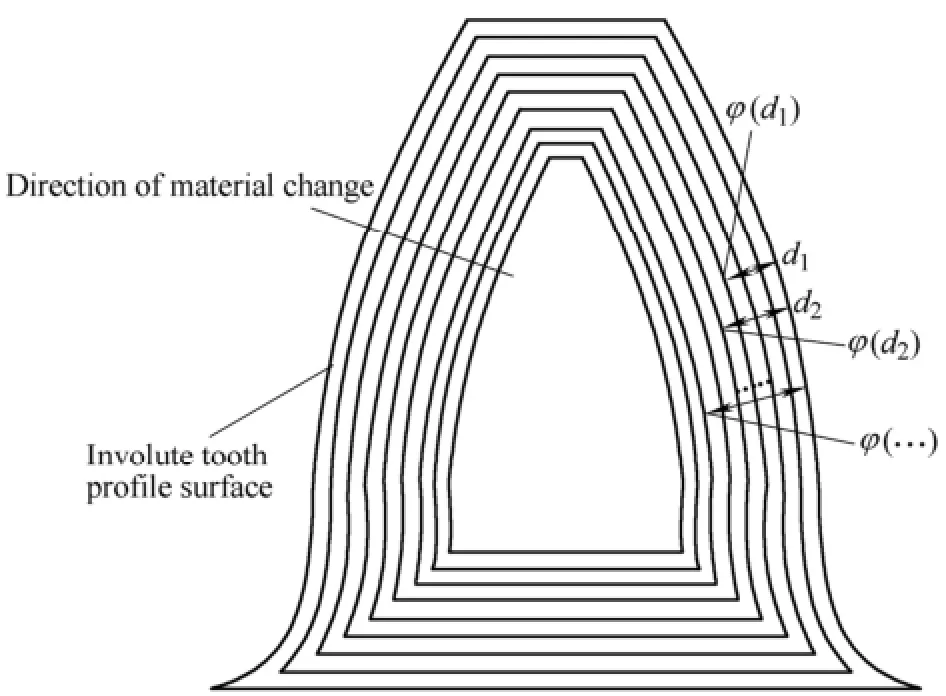
Fig. 1. Schematic diagram of the material distribution of FGM gear tooth
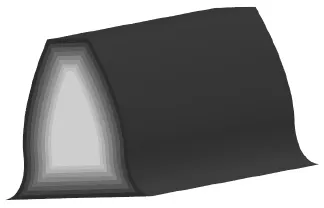
Fig. 2. 3D model of FGM gear tooth
With the changing of material distribution function φ=φ(d), the weight of tooth also changes; and mechanical property of tooth changes as well, for which under the same load, the maximum bending stresses and maximum deformations are also different. That is to say,adjusting the material distribution function of FGM gears can achieve relatively reasonable results, including weight,bending stress and deformation of gears. As a result, after determining the material distribution form of FGM gears,the change of material volume fraction φ, i.e., the material distribution function should be designed and optimized,which is the main content researched by this paper.
3 Optimization Scheme
3.1 Performance parameters analysis of FGMs
To analyze the stress and deformation of FGM gears under certain forces, and weight of FGM gears, the mainly related parameters including the Young's modulus E,Poisson's ratio μ and destiny ρ should be calculated first. To illustrate calculation method, here the FGMs containing only two kinds of materials are analyzed.
According to heterogeneous materials mechanics[19], the relations of bulk modulus K, shear modulus G, Young's modulus E and Poisson's ratio μ at a particular spot of FGMs can be illustrated as follows:
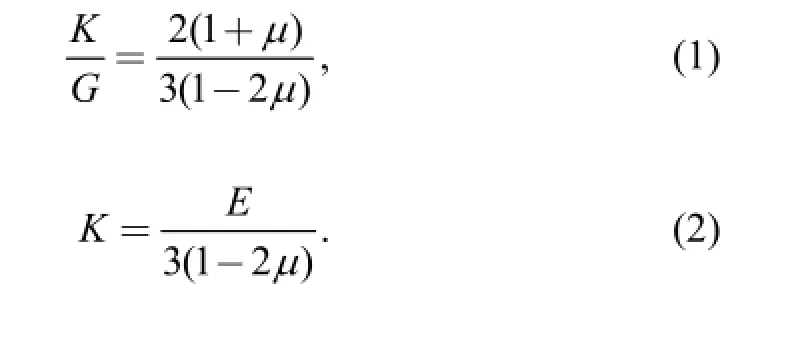
From Eqs. (1) and (2), Young's modulus E and Poisson's ratio of FGMs μ can be obtained:

To calculate bulk modulus K and shear modulus G, there are the following two equations[20]:
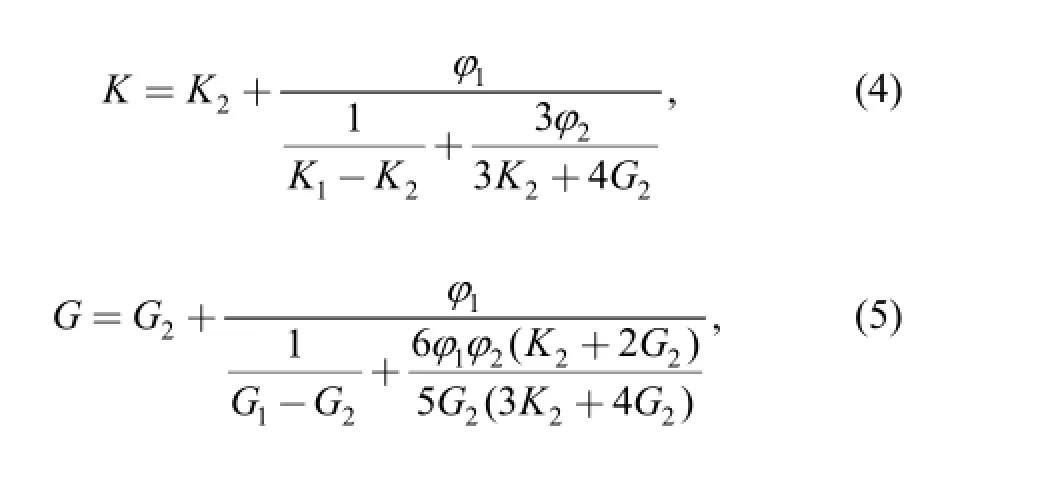
where1φ,2φare volume fractions of the two materials composing FGMs respectively, and they are related through the following form:

The values of K1,K2,G1and G2depend directly on Young's modulus and Poisson's ratios of the two materials:

whereE1,E2are Young's modulus of the two materials,respectively, and μ1,μ2are Poisson's ratios of the two materials, respectively.
In addition, the density of FGMs can be calculated based on the rule of mixture[21]:

where ρ1,ρ2are respectively densities of the two materials contained in FGMs.
According to the above analyses, the Young's modulus E,Poisson's ratio μ and density ρ of FGMs can be calculated. On the basis of density calculating, weight of the FGM gears can be obtained; and on the basis of Young's Modulus and Poisson's ratio calculating and through the finite element analysis, the maximum bending stress and the maximum deformation of FGM gear tooth can be obtained.
3.2 Optimization model
Seen from Eqs. (7)-(10) of section 3.1, when the kinds of two materials composing FGM gears are determined, i.e.,values of E1, E2and μ1,μ2are determined, then values of K1,K2,G1and G2can be obtained. From Eq. (3) it can be found that Young's modulus E and Poisson's ratio μ are functions of bulk modulus K and shear modulus G,both of which are functions of material volume fractionsAs a result, Young's modulus E and Poisson's ratio μ of FGMs are functions of material volume fractionsAs a result, Young's modulus E and Poisson's ratio μ of FGMs are functions of material volume fractionsand Eq. (11) demonstrates that destiny ρ is also function ofFurthermore, fromit can also be said that Young's modulus E, Poisson's ratio μ and destiny ρ are functions ofdenoted by φ in brief in this paper.
As mentioned in section 2, in the representation of FGMs,material volume fraction is generally a function called material distribution function, which considers distance d from the studying point to the reference feature as variable. At present there are many kinds of materials distribution function forms proposed by various researchers, such as polynomial function, exponential function and power function, etc. According to Taylor's theorem:

We can see that exponential function, power function and trigonometric function can all be developed into polynomial function by using Taylor formula, and polynomial function can not only effectively describe the material distributions,but also facilitate the calculation and analysis of material property parameters. Therefore polynomial function is chosen as the material distribution function of FGM gears:

In this case, after determining the two materials, Young's modulus E, Poisson's ratio μ and destiny ρ of FGMs are directly related to coefficients a0,a1,a2,…,anand order n of the material distribution function. This paper chooses quadratic polynomial (n=2) as the material distribution function to conduct optimum design of FGM gears:

In finite element analysis of FGMs, because the material property parameters, such as Young's modulus and Poisson's ratio cannot be directly set to change continuously with the continuous variation of distance in Ansys Workbench, most of the researches use multilayer stacking method to approximate material change in FGMs. FGMs are divided into layers, for each of which the material is homogeneous, but the material compositions and performance parameters between layer and layer are different. The above mentioned operation is a discretization processing of FGM model. In order to simplify the domain of d, the normalization method is used to limit it between 0 and 1, as shown by Eq. (15):

where dminand dmaxrespectively denote the minimum and maximum values of d, and generally dmin=0;L denotes the layer of the calculated points, and L=1, 2,…, n,where n is the total number of layers; Δd is the thickness of each layer.
Thus it can be determined that the design variables of the desired optimization model are a0,a1,a2. Due to problems such as agglutination failure and noise caused by gear mesh error, the increase of gear transmission speed and load are limited by a certain degree. And one of the main reasons causing the meshing error is that the elastic deformation of loaded gear tooth makes meshing position of gear pair instantaneously change in the transmission process[22]. On the other hand, gear failures are often encountered in engineering practice, for example, tooth root fracture, which is due to that the bending stresses of tooth roots of the loaded and meshing gears are very large and under cyclic load the fatigue cracks come into being,resulting in tooth damage or broken finally[23]. At the same time, therefore, the maximum deformation and stress of gears should be constrained to be less than allowable values. Note that the allowable stress of FGM gears is also a function of material volume fraction. To perspicuously illustrate the main optimization process, here the minimum allowable stressis given, as the constant constrain value of stress.
According to the above analyses, a multi-objective optimization problem can be formed in the following form:

where f denotes weight of gear, and δ represents the maximum deformation of gear; σ andare the maximum stress of gear and the allowable stress,respectively; the value of d can be obtained by Eq. (15).
For FGM gears, so far there is no accurate theoretical calculation formula for solutions of deformation δ and stress σ, hence the finite element software Ansys Workbench is used. By design of experiment (DOE) method, different design points, i.e.with different values are generated. And then through finite element analysis in Ansys Workbench the corresponding results including deformation and stress at these design points can be obtained, which are necessary in the final optimization process.
4 Experimental Analysis
Automobile industry is a large fuel consumption part and reducing vehicle weight can reduce fuel consumption and exhaust emissions, which can consequently facilitate the environment pollution abatement[24]. Therefore, the automobile industry departments and the environmental protection departments in the world are paying more and more attentions on how to reduce weight of cars. One of the effective ways to reduce the overall car weight is to reduce the weight of the automotive transmission gears[25]. With an automotive transmission gear as an example, this paper use the proposed method for gear lightweight design.
The kinds of materials compositing the FGM gear should be determined first. Ultralumin 7A04 can be used to make lightweight gears because of its small destiny and relatively high strength. However, this kind of gears are still unable to transfer too large torques and shocks, otherwise the fatigue cracking will happen in the position of keyway or tooth root. Although much stronger than that of ordinary aluminum, its wear resistance and strength are still poor compared with that of steel. The hardness of 20CrMnTiH that is a common kind of gear steel is higher, which improves the surface contact strength and friction strength of gears, however its density is larger and consequently the weight of the gear made of it is bigger as well. For these reasons, Ultralumin 7A04 and gear steel 20CrMnTiH are chosen for composing FGM gear and optimization design, which not only guarantees the main performances of the gear, but realizes gear lightweight.
In this example, we take the first driving gear of a three-shaft type transmission of truck as the research object. The main parameters are as follows: the gear modulus is 4 mm, the number of teeth z is 20, and the pressure angle 20°;for 7A04, Young's modulus E1=72 GPa, Poisson's ratio μ1=0.33,and destiny ρ1=2.8 g/cm3;and for 20CrMnTiH, Young's modulus E2=207 GPa, Poisson's ratio μ2=0.25,and destiny ρ1=7.8g/cm3.Through specific force analysis of the gear under practical working conditions, it is found that the normal load acting on the line of action of the meshing gears is Fn=2000 N. Thus in the computing process of finite element software Ansys Workbench, the uniformly distributed load of 2000 N is put on the surface centered on the line of action of the meshing gears. To reduce the computation time and improve the computation accuracy, here we only conduct finite element analysis on a part of FGM gear, as shown in Fig. 3. With reference to the allowable stresses of 20CrMnTiHand 7A04[26], the allowable stressis determined to be 300MPa.
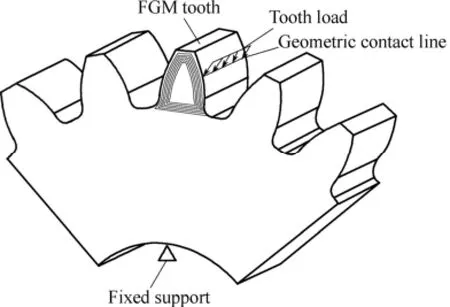
Fig. 3. Part of FGM gear in analysis
In this paper, thickness Δd of each layer is 0.5 mm;dmin=0,dmax=4 mm,and the total number n of layers here is 9. And then according to Eq. (15) the discrete values of distance d for each layer can be obtained, as shown in Table 1.
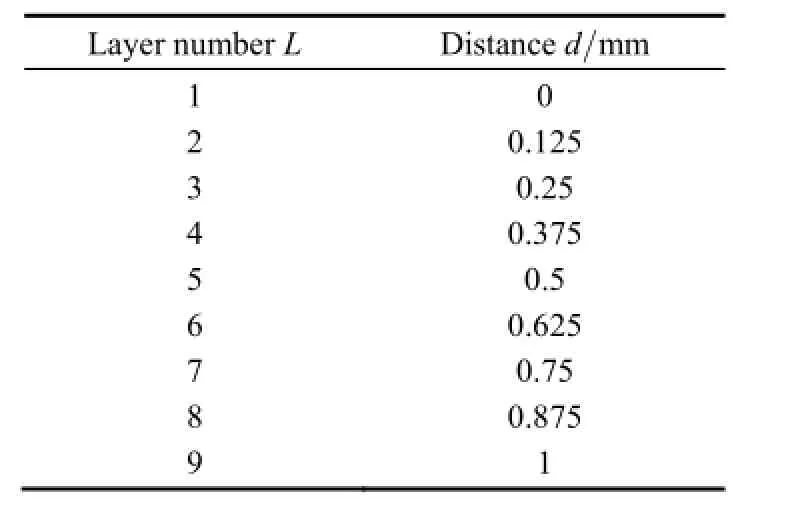
Table 1. Discrete values of distance d
The optimization model (i.e., Eq. (16)) shows that we need both of the deformation under load and weight of gear to be minimum, which is a multi-objective optimization design problem. For this optimization problem, the goal driven optimization (GDO) method of Ansys Workbench is used. GDO is a constrained, multi-objective optimization technique in which the “best” possible designs are obtained from a sample set given the goals set for parameters. In most cases, for multi-objective optimization design problems the two objectives (deformation and weight)cannot to be minimized at the same time. To guarantee the proper performances of the chosen automotive transmission gear, the maximum deformation under load is required to be less than a target value according to the practically operational requirement[27]. Therefore, in the actual computation of Ansys Workbench, we set the weight of gear to be minimum and the deformation under load to be less than the target value 2 μm. In Ansys Workbench, the GDO system contains three parts: DOE, Response Surface and Optimization. Firstly different design points aregenerated through DOE. And then based on a correlation analysis using the generated sample points that are located throughout the entire space of input parameters, the global,statistical sensitivities can be gotten. Global, statistical sensitivities do not depend on the values of the input parameters, because all possible values for the input parameters are already taken into account when determining the sensitivities. Finally in the Optimization part three candidate points based on GDO are finally obtained, as provided in Table 2.

Table 2. Candidate points based on GDO
As Table 2 shows, both of the maximum deformation and weight of gear corresponding to Candidate A are smaller, compared to the other two candidate points. Therefore, candidate A is chosen as the optimum result, i.e.,a0=0.337 41,a1=0.46134,a2=-0.739 23,and the weight and maximum deformation of FGM gear are 164.23 N and 1.9339μm,respectively. And hence the optimum material distribution function can be formulated:

Fig. 4 demonstrates the variation of material volume fractions. As can be seen from Fig. 4, with the increase of the layer number, the volume fraction of 7A04 first increases and then decreases to minimum in the innermost layer of gear tooth, and the maximum value is no more than 45%; while the volume fraction of 20CrMnTiH first decreases and then increases to maximum in the internal gear tooth, and the minimum value is no less than 55%; the volume fractions of 7A04 material and 20CrMnTiH respectively reach the maximum and minimum values near the position with distance d of 0.3 mm, which is located between the third and fourth layer, as Table 1 shows. These results show that 20CrMnTiH still occupies the main part compared to 7A04, because the mechanical property of gear has to be guaranteed when reducing the gear weight. modulus E and Poisson's ratio μ with the change of distance d. Corresponding to the variation curves of material volume fractions in Fig. 4, with the increase of the layer number, Young's modulus value of FGM gear first decreases and then increases while Poisson's ratio first increases and then decreases. And near the position with distance d of 0.3 mm, Young's modulus and Poisson's ratio reach the maximum and minimum values, respectively. This variation trend is consistent with the variation of material volume tractions of 7A04 and 20CrMnTiH,because Young's modulus of 20CrMnTiH is higher than that of 7A04, which makes Young's modulus of FGM decrease when the volume fraction of 20CrMnTiH decreases. On the contrary, Poisson's ratio of FGM increases when the volume fraction of 20CrMnTiH decreases.
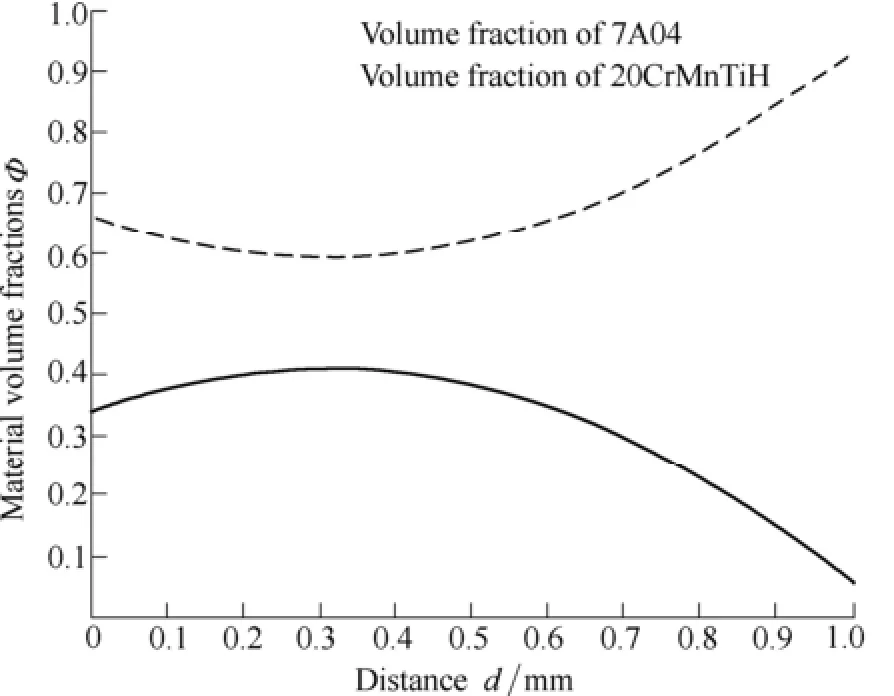
Fig. 4. Optimal material distribution functions
Fig. 5 illustrates the variation tendency of Young's
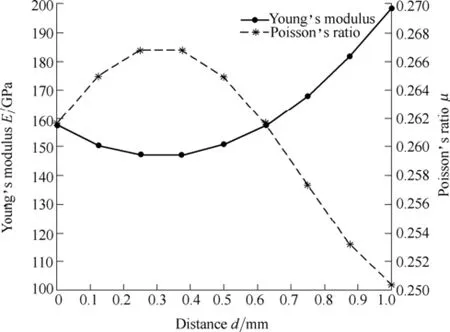
Fig. 5. Variation tendency of Young's modulus and Poisson's ratio
When a0=0,a1=0,a2=0,i.e., the whole gear is composed of only 20CrMnTiH, weight of the analyzed part of gear is 239.37 N and the maximum deformation under load is 1.840 2 μm. While for the FGM gear with the optimal material distribution, weight of the analyzed part of FGM gear is 164.23 N and the maximum deformation under load is 1.933 9 μm, as shown in Table 2. Comparing these results, we can see that the weight of gear is reduced by 31.39% and the maximum deformation increases by5.72% which is within the specified limit. It should be particularly noted that only a part of gear is analyzed in this paper and hence the reduction value of gear weight when applying FGM tooth on the whole gear is predicatively larger than 31.39%. This implies that under the condition of keeping the normal working performance of gear, the proposed method achieves in greatly reducing the gear weight. In addition, the price of 20CrMnTiH is around twice as much as that of 7A04, meaning that applying FGMs to gears can also make full use of materials and reduce material costs of gears. It can also be expected that in the application of the proposed method, the larger the gear is, the more remarkable the effect will be.
5 Conclusions
(1) Aimed at the lightweight problem of gears, a FGM gears design method is presented, which is able to largely reduce the weight of gears by optimizing the microscopic parameters instead of changing the macroscopic parameters of gears.
(2) A kind of automotive transmission gear is used as an example to illustrate the optimization design process. By comparing the weight of the optimal FGM gear with that of the homogeneous 20CrMnTiH gear, the results indicate that the proposed method can greatly reduce the gear weight,and the material costs of gears can also be lowered as an additional advantage.
(3) Although this developed method mainly applies FGM to gear teeth, it is also feasible if the whole gear is considered. Then the FGM gear model needs to be redesigned and the weight reduction effect is expected to be more significant.
(4) Due to the limited accuracy and resolution inherent in the AM process, some designed FGM gears cannot be printed exactly. This means that the printability should be taken as a constraint of the optimization model.
(5) In the finite element analysis process of the FGM gears, adopting discrete accumulation method to approximate FGMs will inevitably cause errors of FEA results and also limit the improvement of optimization methods. Therefore, methods for more accurate stress value and deformation value of FGM gears, for example finding the analytical expressions, need to be explored. These mentioned problems will be considered and researched in our future work.
[1] FAN Q R, IKEJO K, NAGAMURA K, et al. Application of statistical parameters and discrete wavelettransform to gear damage diagnosis[J]. JSME Journal of Advanced Mechanical Design,Systems, and Manufacturing, 2014, 8(2): 1-12.
[2] REDDA D T, NAKANISHI T, DENG G. Softening behavior of hardness and surface fatigue of rolling-sliding contact in the case of developed alloy steels[J]. JSME Journal of Advanced Mechanical Design, Systems, and Manufacturing, 2009, 3(1): 85-92.
[3] ZAREFAR H, MUTHUKRISHNANB S N. Computer-aided optimal design via modified adaptive random-search algorithm[J]. Computer-Aided Design, 1993, 25(4): 240-248.
[4] WANG H, WANG H P. Optimal engineering design of spur gear sets[J]. Mechanism and Machine Theory, 1994, 29(7): 1071-1080.
[5] YOKOTA T, TAGUCHI T, GEN M. A solution method for optimal weight design problem of the gear using genetic algorithms[J]. Computers & Industrial Engineering, 1998, 35(3): 523-526.
[6] SAVSANI V, RAO R V, VAKHARIA D P. Optimal weight design of a gear train using particle swarm optimization and simulated annealing algorithms[J]. Mechanism and Machine Theory, 2010,45(3): 531-541.
[7] SHANMUGAVEL P, BHASKAR G B, CHANDRASEKARAN M,et al. An overview of fracture analysis in functionally graded materials[J]. European Journal of Scientific Research, 2012, 68(3): 412-439.
[8] ATAI A A, NIKRANJBAR A, KASIRI R. Buckling and post-buckling behaviour of semicircular functionally graded material arches: a theoretical study[J]. Proceedings of the Institution of Mechanical Engineers, Part C: Journal of Mechanical Engineering Science, 2012, 226(3): 607-614.
[9] MAHAMOOD R M, AKINLABI E T, SHUKLA M, et al. Functionally graded material: an overview[C]//Proceedings of the World Congress on Engineering (WCE 2012), London, UK, July 4-6, 2012: 1593-1597.
[10] ZHANG Zhengyan, WANG Xiaoping, HU Jiquan, et al. Representation algorithms of multi-materials part for rapid prototyping[J]. Chinese Journal of Mechanical Engineering, 2013,49(3): 163-173. (in Chinese)
[11] OBATA Y,NODA N. Optimum material design for functionally gradient material plate[J]. Archive of Applied Mechanics, 1996,66(8): 581-589.
[12] NADEAU J C, FERRARI M. Microstructural optimization of a functionally graded transversely isotropic layer[J]. Mechanics of Materials, 1999, 31(10): 637-651.
[13] TANIGAWA Y, OKA N, AKAI T, et al. One-dimensional transient thermal stress problem for nonhomogeneous hollow circular cylinder and its optimization of material composition for thermal stress relaxation[J]. JSME International Journal, Series A,Mechanics and Material Engineering, 1997, 40(2): 117-127.
[14] TANAKA E, NAGAMURA K, IKEJO K, et al. In situ diagnosis of a gear-tooth surface damage using laser scattering[J]. JSME Journal of Advanced Mechanical Design, Systems, and Manufacturing, 2011,5(3): 199-213.
[15] YAN Xiaolei, ZHONG Zhihua, ZHA Yunfei, et al. Optimum design of flywheel rotor made of functionally graded materials[J]. Chinese Journal of Mechanical Engineering, 2011, 47(2): 72-79. (in Chinese)
[16] TORABIZADEH M A. Geometrically nonlinear bending analysis of Metal-Ceramic composite beams under thermo mechanical loading[J]. Chinese Journal of Mechanical Engineering, 2013,26(4): 701-713.
[17] LV Tianjie, LI Qiang. Feasibility analysis of functionally gradient material used on gear[J]. Journal of Mechanical & Electrical Engineering, 2012, 29(4): 381-384. (in Chinese)
[18] CANNILLO V, MANFREDINI T, SILIGARDI C, et al. Glass-alumina functionally graded materials: their preparation and compositional profile evaluation[J]. Journal of the European Ceramic Society, 2006, 26(13): 2685-2693.
[19] WANG Baolin. Mechanics of inhomogeneous materials[M]. Beijing: Science Press, 2003.
[20] MORI T, TANAKA K. Average stress in matrix and average elastic energy of materials with misfitting inclusions[J]. Acta Metallurgica,1973, 21(5): 571-574.
[21] BAYAT M, SAHARI B B, HAMOUDA A M S, et al. On the stress analysis of functionally graded gear wheels with variable thickness[J]. International Journal for Computational Methods in Engineering Science and Mechanics, 2008, 9(2): 121-137.
[22] LI Shuting. Finite element analyses for contact strength and bending strength of a pair of spur gears with machining errors, assembly errors and tooth modifications[J]. Mechanism and Machine Theory,2007, 42(1): 88-114.
[23] TANAKA K, TANAKA Y, ENOMOTO K, et al. Design of thermoelastic materials using direct sensitivity and optimization methods. Reduction of thermal stresses in functionally gradient materials[J]. Computer Methods in Applied Mechanics and Engineering, 1993, 106(1-2): 271-284.
[24] HIRSCH J. Aluminium in innovative light-weight car design[J]. Materials Transactions, 2011, 52(5): 818-824.
[25] ZHANG Yong, LI Guangyao, ZHONG Zhihua. Design optimization on lightweight of full vehicle based on moving least square response surface method[J]. Chinese Journal of Mechanical Engineering,2008, 44(11): 192-196. (in Chinese)
[26] MYER K. Handbook of materials selection[M]. Fresno: WiterwoofInc, 2008.
[27] LI Shuting. Deformation and bending stress analysis of a three-dimensional, thin-rimmed gear[J]. Journal of Mechanical Design, 2001(1): 129-135.
Biographical notes
JING Shikai, born in 1975, is currently a lecturer and a master candidate supervisor at School of Mechanical Engineering, Beijing Institute of Technology, China. He received his PhD degree from Northwestern Polytechnical University, China, in 2005. His research interests include product data management, knowledge management, design theory and method, and manufacturing services technology.
Tel: +86-13321166219; E-mail: jingshikai@bit.edu.cn
ZHANG He, born in 1991, is currently a master candidate at School of Mechanical Engineering, Beijing Institute of Technology,China. His main research interests include additive manufacturing and functionally graded materials.
Tel: +86-15510726210; E-mail: zhanghe5678@163.com
ZHOU Jingtao, born in 1976, is currently an associate professor and a master candidate supervisor at Northwestern Polytechnical University, China. His research interests include enterprise information integration, artificial intelligence and Semantic Web.
E-mail: jtzhou.office@gmail.com
SONG Guohua, born in 1984, is currently a PhD candidate at School of Mechanical Engineering, Beijing Institute of Technology,China. His main research interests include additive manufacturing and topology optimization.
E-mail: hnlgdxsgh@126.com
10.3901/CJME.2015.0930.118, available online at www.springerlink.com; www.cjmenet.com; www.cjme.com.cn
* Corresponding author. E-mail: jingshikai@bit.edu.cn
Supported by National Hi-tech Research and Development Program of China (863 Program, Grant No. 2015AA042505)
© Chinese Mechanical Engineering Society and Springer-Verlag Berlin Heidelberg 2015
April 7, 2015; revised September 15, 2015; accepted September 30, 2015
杂志排行
Chinese Journal of Mechanical Engineering的其它文章
- Influence of Alignment Errors on Contact Pressure during Straight Bevel Gear Meshing Process
- Shared and Service-oriented CNC Machining System for Intelligent Manufacturing Process
- Material Removal Model Considering Influence of Curvature Radius in Bonnet Polishing Convex Surface
- Additive Manufacturing of Ceramic Structures by Laser Engineered Net Shaping
- Kinematics Analysis and Optimization of the Fast Shearing-extrusion Joining Mechanism for Solid-state Metal
- Springback Prediction and Optimization of Variable Stretch Force Trajectory in Three-dimensional Stretch Bending Process
